To my department on Monday, an announcement of a special event
4-6 on Sunday [January 26], in the lobby of Margaret Jacks, to celebrate my 25th anniversary at Stanford: a shapenote singing by the peninsula Sacred Harp singers. I’ll post some description of the tradition and practices of shapenote singing very soon; the briefest of descriptions is that it’s four-part a cappella white gospel music that flowered in the rural deep South in the 19th century and has been handed down as a folk tradition. More details to follow.
A crucial bit is that the singers sing for and with one another, not for an audience — it’s participatory music, not a performance — though on certain occasions (like this one) listeners are welcome (and invited to participate, if they wish).
Special thanks to Elizabeth Traugott, who arranged my peculiar appointment on the Stanford end, and to Ilse Lehiste, who arranged things on the Ohio State end, and to Lise Menn, who, when I asked Facebook friends about how to celebrate my 25th anniversary, suggested:
Get some musician friends together and give an outdoor concert!
Well, it’s not actually outdoors, but just inside the doors of Building 460 (Margaret Jacks Hall) at Stanford.
Readers who will be in the area Sunday afternoon are welcome to join us.
Now some background on shapenote singing.
Here’s a two-page description put together a few years ago for people who are new to the practice (click on each page to embiggen it some):
There are further links on the fasola site.
The music, sung in this fashion, is raw, coarse, and noisy, even grating, nothing a choir director would cherish or encourage. Some people — my friend and sometime collaborator Geoff Pullum is one — just hate the music. Other people think it sounds vaguely “Balkan” and find it attractive if weird.
There are lots of recordings out, many of them of traditional singing. Unless these recordings have been carefully engineered, they aren’t easy for new listeners to find their way around in: the altos, with their loud, rasping tone, are likely to stand out as the dominant line, despite the fact that in most songs the alto part is there to fill in chords and doesn’t make much sense on its own; and the line that stands out on top (the treble line) isn’t the melody either, but instead is high harmony or (sometimes) a counter-melody crossing over the actual melody line, the tenor.
There are other recordings, some of them beautifully performed and thoroughly enjoyable, that treat the music as choral sacred music (the Boston Camerata, His Majestie’s Clerkes) or as folk music in an Appalachian style (Anonymous 4), but they don’t give the flavor of deep-South Sacred Harp singing.
As for the look of the music, here are some samples, starting with two simple songs often used as “warm-ups” at singings: St. Thomas and Ninety-Fifth:
Remember that the melody line is the third one down. And note that whichever line you sing, you’ll have to look elsewhere on some of the verses to find the words you’re supposed to be singing — a fact that makes “singing the shapes” first a genuinely useful practice.
For St. Thomas, the tenors start by singing SO-FA-FA-LA-SO-FA-SO, the trebles (I’m usually a treble) FA-LA-LA-SO-SO-LA-SO, etc. (Notice that there are two different SOs in each case, sometimes representing the fifth note of the scale, sometimes the second. The major scale goes FA-SO-LA FA-SO-LA-MI FA, the minor scale LA-MI-FA SO-LA-FA-SO LA.)
Both these songs have been typset in the key of A, and that’s (approximately) the key I lead them in, but another leader might pitch them anywhere from G through B. Singers with perfect pitch find this choice of “keys of convenience” unsettling.
Then a familiar text and tune, New Britain:
The “Amazing Grace” text is set to one tune in New Britain, but to a quite different, bouncier, one in Jewett (105), which breaks out into a “shouting song” chorus. Many other texts have been set to a variety of tunes, and sometimes a familiar tune has a new text set to it.
Finally, two “new songs”, Natick and Wood Street:
Wood Street has a “fuguing” chorus, with the parts entering at different times and singing against each other for a while. It’s also in a minor key, and has been set by Judy Hauff so as to insist on the raising of the sixth note of the minor scale that is traditional in Southern Sacred Harp singing. And it has a really nice alto part. All in all, a wild and wonderful song, even if it does stretch the trebles on the top. (Notice that the basses get a choice of octaves on some notes, just in case the leader has pitched the song down some as a kindness to the trebles.)
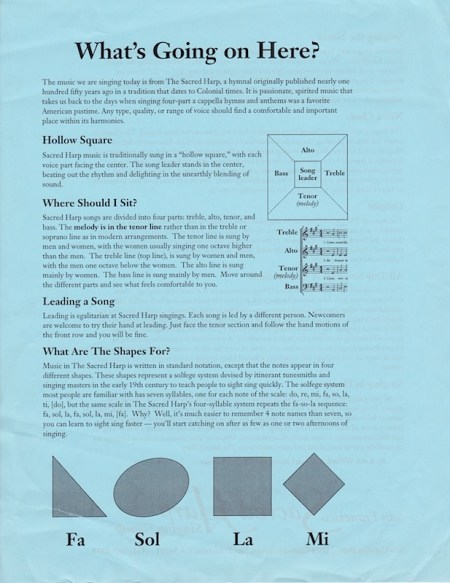
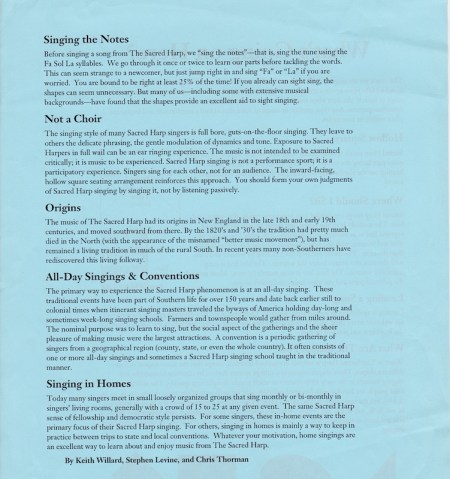
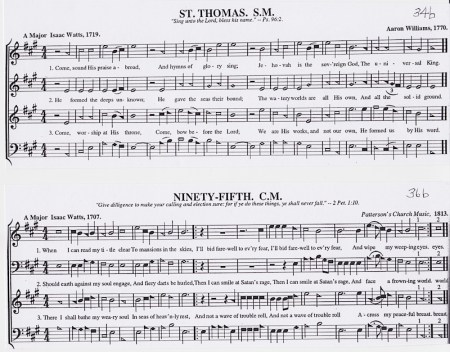
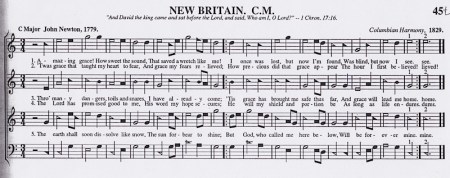
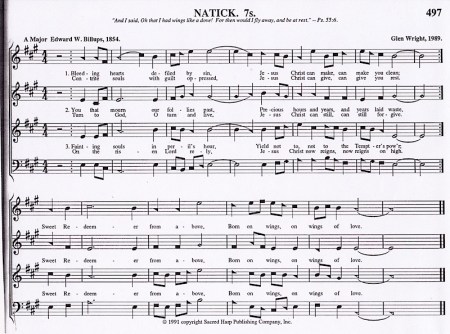

September 23, 2010 at 1:34 pm |
Congratulations. Lise’s suggestion is excellent. Go with it
Not so fast. I live with a choir director, who certainly cherishes and encourages shape note singing, inter alia. Maybe this is more for the Columbus Women’s Chorus than the church choir (not big enough), the Magpie Consort or the Otterbein Women’s Chorale (perhaps too young and sweet).
September 23, 2010 at 2:15 pm |
Note to the readership: Chris and I are technically colleagues at Ohio State, though I don’t think we’ve ever met. I left for California before he arrived to take up a Real Faculty Position at OSU.
Now to Chris: I don’t doubt that your cohabitant choir director cherishes and encourages shapenote music, but I’m pretty dubious that any choir director encourages the musical practice of Sacred Harp singers in their choir. (I participated in a wonderful Stanford class that Marsha Genensky, of Anonymous 4, taught five years ago. Marsha and I did a series of contrasting renditions of the same song, separately and together, and it was an amazing eye-opener for the students, who’d never heard anything like my style of singing, especially for sacred music.)
In my experience, choir directors are often fascinated with the music — like, music on the page — but as choir directors they are utterly repelled by what they see as raw, crude, unrefined performances by traditional singers. (That doesn’t mean that some of them can’t get down with the style when they’re not being choir directors.)
September 23, 2010 at 5:39 pm |
We did meet, but barely, at an Emeritus lecture, then again, perhaps, at a Womens’ Chorus Concert. I’m not sure if we talked. Maybe not.
I just cleared with Sheena ( http://www.sheenaphillips.com ) the idea that when Arnold is back in Columbus he should come and show us what he he means. We think Sheena won’t be shocked, but who knows? I immediately concede that no style works for every piece, but sucking on the sugar cane can be as good as or better than stirring Tate and Lyle’s finest hand-carved sugarlumps into those delicate bone china cups. Indeed, if the tea’s good, hold the sugar, no matter how refined.
I’m still trying to work out what makes a faculty position Real. Two possible answers:
a) Peter Ladefoged had one, but no-one else before or since
b) It’s something to do with sponsorship from the Spanish Royal Family.
Either way, my plea is “not guilty”.
September 23, 2010 at 7:09 pm |
On Real Faculty Positions (in the U.S.): you know if you’re Real if (a) your title has Professor as its head word (Instructor, for example, won’t do), and (b) its modifier is zero, Associate, or Assistant (Visiting or Adjunct, for example, won’t do). You, Chris, are an Associate Professor, so you’re Real; I am, have been, and always will be, a Visiting Professor at Stanford, so I’m not.
As for Sheena’s response to down-home Sacred Harp singing, she could listen to some of the traditional tracks, complete with their famous “paint-peeling” altos. But of course she might be delighted by this music, while still being unwilling to teach it to choral-practice students. Marsha G. did sort of teach the style to such students (with me as her exemplar), but only as an alternative style in a historically oriented course; in real life she’s been learning, respectfully, to sing in this style (she admits to wanting to be a specific one of the paint-peeling altos on recordings we both have), but that’s not the way A4 sing at all.
October 17, 2010 at 7:42 am |
[…] to my postings on shapenote singing (here here and […]
December 13, 2010 at 11:21 am |
[…] Christmas, the Winter Solstice, and New Year’s. (Some information on shapenote singing here and here.) Afterwards we had a nice dinner together and talked of many things, some of then […]
August 16, 2011 at 4:57 pm |
[…] the last of these: Yesterday in Sunnyvale, I led the peninsula shapenote singers in a memorial song for her. Not one of my usual ones, but an extravagant, transcendant, […]
June 10, 2013 at 3:18 pm |
[…] response to a query from a friend a little while back, I sent a link to a 2010 posting of mine on shapenote singing and the Sacred Harp tradition. Now I’ve tried to assemble the […]
May 17, 2014 at 8:29 pm |
♬ Hah! 🙂 ♬
I have always loved folk music and choral singing, together or separately. (I had a button made: “Choral singing: the most fun you can have in public”.) And I have been piqued and pleased by shape-note singing ever since I first encountered it.
In the week before last Christmas I heard carolers outside on our street, and after a few moments I realized they were singing shape-note music. It was a warm night, and I ran outside in my house slippers to listen, and then to join in, picking up the part from singers in my range. I wound up staying with them for the next two hours, winding up at a party, and since then joining their monthly sings at a storefront near my home when I can.
May 17, 2014 at 8:49 pm |
Lovely. We do recruit singers!